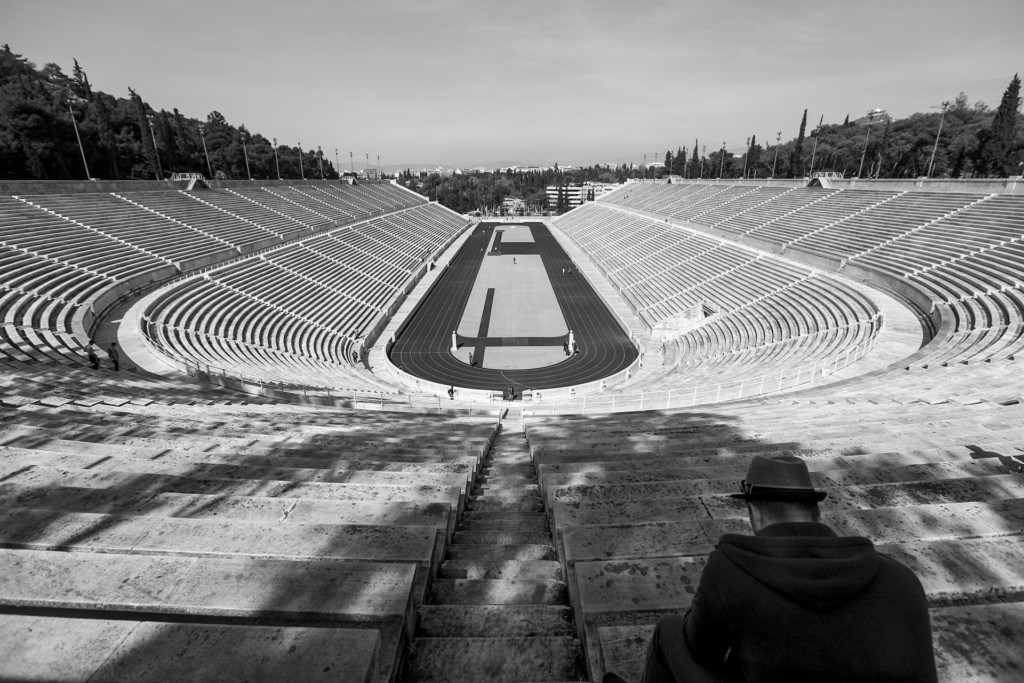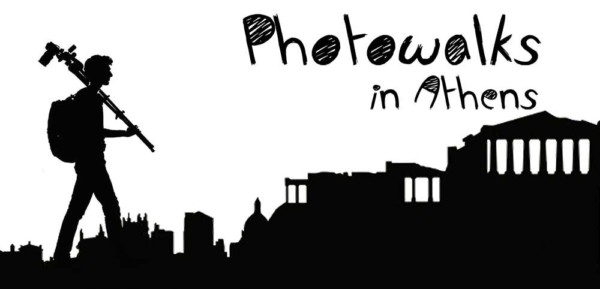Panathenaic Stadium
A very photo-inspiring visit among our Photo Walks!
This huge marble structure set in a small valley by Ardittos Hill occupies the exact site of the original Panathenaic Stadium which represents probably one of the major public works projects of Athenian statesman Lykourgos, built in 330/29 BC for track events in the Greater Panathenaia festival. Before this stadion was built these events were held in the Ancient Agora, although some scholars argue for the Classical Agora as the setting. As there is no physical evidence to support this universally held belief. Professor David Romano (University of Pennsylvania) has argued instead that Lykourgos stadion was built actually on the Pnyx hill instead of here.
The earliest stadion was built in the natural gully between Ardittos Hill to the west and another hill to east. The plan of the stadion consisted of a dromos or flat track for running events, with a rectangular theatron surrounding it for seating. The structure is open at the north end. Repairs were undertaken c. 250/225 BC and again in the earlier Roman period. By Hadrian’ s reign (AD 124 – 138) the stadion had been reconfigured for use for gladiatorial contests.
The Athenian sophist and magnate Herodes Atticus constructed a new stadium in Pentelic and Hymettan marble ashlar masonry between AD 139/40 and 143/4 (finished in time for the celebration of the Panaheniac festival), in the form of Roman- style stadium with a semicircular sphendone and slightly curving sides.
The central spine of the track had at least one Apollo and Hermes double – headed herm (now in the National Museum). There was a vaulted tunnel (vomitorium) with an L-shaped plan for the participants entering the stadion from the southeast. The structure measures 204×83 m. The 66 separate seating blocks are divided into three sections. Two diazomata connect them. It seated at least 50.000 spectators, the same capacity as the Colosseum in Rome!
According to Katherine Walsh (Institute of Fine Arts, New York University) this monument and his Odeion were used as an architectural means of self – representation for Herodes Attikos. The stadium makes allusions to the Classical past (i.e. the use of marble ashlar masonry instead of concrete: the lack of extensive vaulting and the access to the cavea by a vomitorioum: the used of carved owls to decorate the cavea) but at the same time is unmistakably contemporary (i.e. scale: curved sphendone, provisions for protecting the spectators from the wild animals used in the spectacles held here). It is an impressively old-fashioned structure which attempts to find the middle ground between the activities of two conflicting cultures (the use for the traditional contests of the ancient Panathenaic festival vs. the use for Roman spectacles).
The stadium was gradually destroyed over the years by robbing of its marble and other stone for later structures. In the process it was filled in gradually with debris. At the same time as the stadium was built, a three arched bridge was constructed over the Ilissos river. This stood until 1778, when it was destroyed in order to use the building material in the new Ottoman enceinte, the Serpentzes.
On the eastern hill there is a long, oblong foundation of concrete and poros limestone, which may be have been for the tomb of Herodes Attikos, mentioned by Philostratos. Walsh believes that this tomb` s superstructure took the form of monumental altar. This structure was excavated in 1904. Jennifer Tobin (University of Illinois – Chicago Circle), on the other hand, argues with little hard evidence that he was buried beneath the dromos of the stadium. On the western Ardittos hill was the Temple of Tyche.
The area of stadium was known during the Ottoman period as a haunt of witches, where they were thought to perform their witchcraft. Between 1869 – 1870 Ernst Ziller excavated the Stadium. Later, King George I expropriated the land for the state. The monument was restored in 1895 by Anastasios Metaxas, using Ziller` s plans at a cost of 4 million drachmas. As it is clad in marble from Mt. Hymettos it is called Kalimarmaro. On 5 April 1896 it was dedicated for first meeting of the revival of the modern Olympics.
The Stadium is the finishing point for the contemporary Marathon race which was held each October. This is a modern reenactment (first held during the inaugural modern Olympic Games, staged in Athens in 1896) of the run of the Athenian hoplite (heavily armed soldier) Pheidippides who, in 490 BC, sped from the battlefield at Marathon in northeastern Attica, where the Athenians and their allies the Plataians had just defeated the superior forces of the Persian King Darius to announce to his fellow citizens that the victory was theirs. He then died immediately from exhaustion. The official distance of the route from the ancient bridge at Marathon to the Stadium is 42.2 km (26.2 miles), which was codified for the 1924 Olympic Games held in Paris. (athens-greece.us)

A very photogenic landmark of Athens that we get to photograph in our photo tours by Photo Walks in Athens in many different photographic styles and character!
Plaka
Book our Photo Walks and explore the tucked-away areas around the slopes of the Acropolis and uncover their ancient and recent past. Our Photo Walk will pass by the most picturesque spots and reveal fantastic photographic opportunities!
Plaka is the old historical neighborhood of Athens, clustered around the northern and eastern slopes of the Acropolis, and incorporating labyrinthine streets and neoclassical architecture. Plaka is built on top of the residential areas of the ancient town of Athens. It is known as the “Neighborhood of the Gods” due to its proximity to the Acropolis and its many archaeological sites.
The name “Plaka” was not in use until after the Greek War of Independence. Instead, the Athenians of that time referred to the area by various names such as Alikokou, Kontito, Kandili, or by the names of the local churches. The name Plaka became commonly in use in the first years of the rule of King Otto. The origin of the name is uncertain: it has been theorized to come from Arvanite “Pliak Athena”, meaning “Old Athens”, or from the presence of a “plaque” which once marked its central intersection.

Monastiraki
Monastiraki is one of the busier neighborhoods and it’s always full of life. A flea market neighborhood and one of the main shopping districts in Athens. An area with a cool vibe, a popular metro station and a large square where youth hang out providing us a variety of great photo opportunities to document Athenian life.
Ancient ruins, shopping streets, busy passersby, street vendors and lots of graffiti will provide witty and lively scenery for plenty of candid and street photography!
The Monastiraki traditional flea market has a festive atmosphere and is the place to be on a Sunday morning in Athens. Collectables and antique shops, vendors selling jewelry, handicrafts and bric-a-brac all ready for a bargain shopping, will be our photographic playground!

National Gardens of Athens & The Zappeion Exhibition Hall
The National Garden (formerly the Royal Garden) is a public park of 15.5 hectares (38 acres) in the center of the Greek capital, Athens. It is located directly behind the Greek Parliament building (The Old Palace) and continues to the South to the area where the Zappeion is located, across from the Panathenaiko or “Kalimarmaro” Olympic Stadium of the 1896 Olympic Games. The Garden also encloses some ancient ruins, tambourines and Corinthian capitals of columns, mosaics, and other features. On the Southeast side are the busts of Ioannis Kapodistrias, the first governor of Greece, and of the Philhellene Jean-Gabriel Eynard. On the South side are the busts of the celebrated Greek poets Dionysios Solomos, author of the Greek National Hymn, and Aristotelis Valaoritis.
The Zappeion Exhibition Hall, one of the outstanding examples of late Athenian classicism, is one of the archetypes of Greek public architecture.
The 1821 Greek War of Independence, which lasted almost eight years, led to the creation of the modern, independent state of Greece. Its Christian-Orthodox inhabitants strove to separate themselves from over 400 years of occupation by the Ottoman Empire and to build on elements of language and history harking back to Ancient Greece.
In 1869, the Greek Parliament allocated 80,000 square meters (860,000 sq. ft.) of public land between the Palace Gardens and the ancient Temple of Olympian Zeus, and also passed a law on 30 November 1869, “for the building works of the Olympic Games”, as the Zappeion was the first building to be erected specifically for the revival of the Olympic Games in the modern world. On 20 October 1888, the Zappeion opened.

Mt Lycabettus
A location used in “Photo Marathon” Photo Walk for an unforgettable closure of an adventurous day! The highest point of the city will offer us 360° spectacular views of Athens to photograph panoramically under the magical Athenian sunset light.
This hill also known as Lycabettos, Lykabettos or Lykavittos (pronounced lekavitos), is a Cretaceous limestone hill in Athens, Greece at 300 meters (908 feet) above sea level. Pine trees cover its base, and at its two peaks are the 19th century Chapel of St. George, a theatre, and a restaurant.
The hill is a tourist destination and can be ascended by the Lycabettus Funicular, a funicular railway which climbs the hill from a lower terminus at Kolonaki (The railway station can be found at Aristippou Street). Lycabettus appears in various legends. Popular stories suggest it was once the refuge of wolves, (lycos in Greek), which is possibly the origin of its name (means “the one [the hill] that is walked by wolves”). Mythologically, Lycabettus is credited to Athena, who created it when she dropped a limestone mountain she had been carrying from the Pallene peninsula for the construction of the Acropolis after the box holding Erichthonius was opened.

Photo Walks in Athens are the right photo tours for you!
Enjoy my chilled, polite, fun and very friendly character along with my expert photographic guidance on a personalised -small participants kept- photo tours guaranteed to put you at your ease and make you see the city from an insider’s point of view and discover the heart and soul of the amazing city of old and modern Athens!
